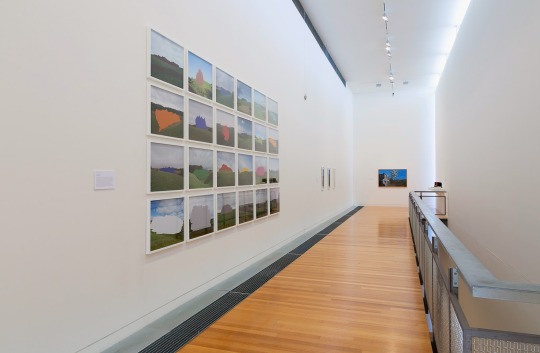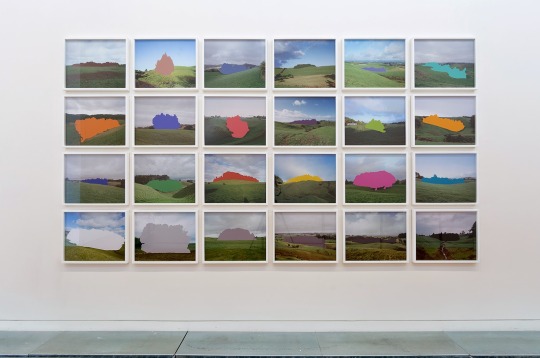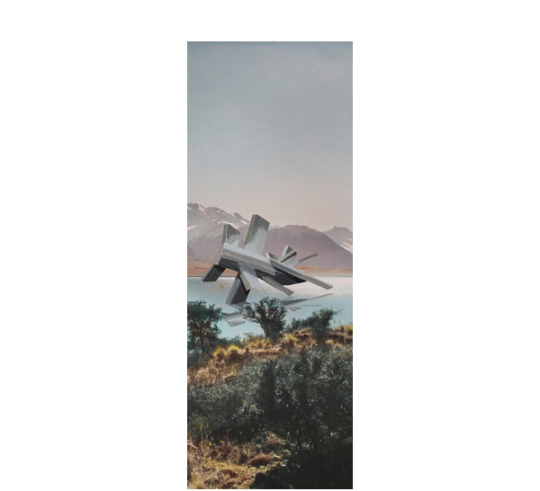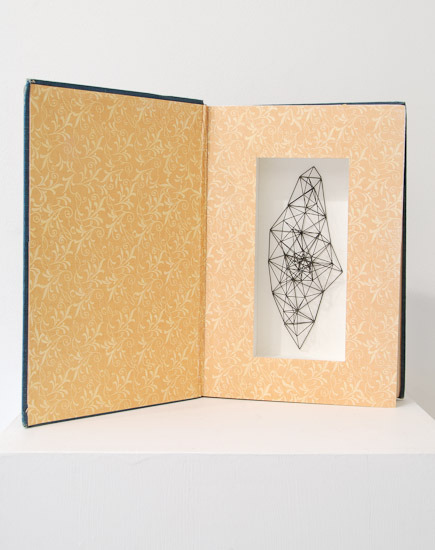Then and Now, Here and Nowhere
By Eleanor Lee-DuncanThe More You Know: The Victoria University of Wellington Art Collection in Context
Adam Art Gallery
February 02 – April 12, 2015

Figure 1 ‘Then and Now, Here and Nowhere’, Installation view by Shaun Waugh Photography, shaunwaughphotography.blogspot.co.nz
The More You Know was comprised of three self-contained suites spread over the three floors of the Adam Art Gallery, which showcased art works from the collection of Victoria University.
On the top floor, the exhibition ‘Then and Now, Here and Nowhere’ re-contextualized the works of Brent Wong against contemporary local Wellington artists, woven together by the thematic thread of flat, geometric or abstracted shapes impossibly juxtaposed against landscapes to provoke a sense of the ‘uncanny’. Whilst emphasizing the continued relevancy of the University Art Collection, it also placed importance on the education through art it presents, as the title ‘The More You Know’ suggested, and then conveyed this to the viewer through the rich text-heavy information throughout the gallery.
‘Then and Now, Here and Nowhere’ contained an array of works by Gavin Hipkins, Peter Trevelyan, Shaun Waugh, Kate Woods, and Brent Wong, spread across several artistic mediums. Wong’s traditionally realist acrylic paintings sit alongside a younger generation of artists who utilize modern or unusual artistic mediums.

Figure 2 Shaun Waugh, ‘Covenant cut-outs’, Image by Shaun Waugh’s Photography shaunwaughphotography.blogspot.co.nz
Shaun Waugh’s ‘Covenant cut-outs’ works are created using photos which he has digitally manipulated to blot out or ‘mask’ large areas of landscape with abstract, flat areas of colour. Seemingly erasing areas of bush growth, these works are concerned with the native tree and bush preservation on private farming land through a landscape project initiated by the Queen Elizabeth II National Trust, which ensures the ongoing preservation of natural and cultural features. 1

Figure 3 Kate Woods, Knin, Image by katejwoods.co.nz
Situated next to these works in the exhibition are Kate Woods’ pieces, which incorporate both traditional and digital media. In this series of three works she has created cardboard sculpted shapes of Spomenik war monuments (Russian post-war sculptures), then painted the faceted surfaces. Finally she photographed them set against found constructed images of New Zealand landscape ‘non-sites’, thereby transforming them from a three-dimensional sculpture into a two-dimensional digital image.2 While Shaun Waugh’s works emphasize the formal removal of, or screening over, a space in a landscape, Kate Woods’ works create layers of imagined fields and fantastical created realms, which the geometric Spomenik shapes sit within. Woods describes the ‘non-sites’, the mysterious worlds within her works as ‘places you will never physically arrive in … yet seem so familiar’- constructed images which appear realistic, yet are artificial.3

Figure 4 An example of Peter Treveyan’s works, 'The art of modern fiction’, image by Bartley and Company, bartleyandcompanyart.co.nz
Peter Trevelyan similarly deals with geometric forms but instead of situating them within a landscape or earthly environment, he sets them aside against a blank white paper background, devoid of context. The works themselves are incredibly small, and arranged out of pencil leads finely glued together. This creates linear sculptures, ‘drawn’, as it were, from pencil, and then situated in cut out paper hollows within vintage, slightly worn books. As an interactive installation, they are intended to be picked up and ‘discovered’ by the viewer, with the novels becoming vessels of information and wonder. Through each of these artists’ works, the uniting theme is of the abstracted otherness of geometric, faceted or flat forms compared to the reality of complex plethora within nature and reality.

Figure 5 Brent Wong, 'Misconception’, image by the Adam Art Gallery, adamartgallery.org.nz
When considering ‘Then and Now, Here and Nowhere’, we could conceptualise the exhibition as presenting us with a non-linear narrative of art history. Rather than reading Wong as a John the Baptist figure or forerunner in a linear art historical narrative, we could read this suite as a cross-generational exhibition in which a small group of artists are interested in the same theme, at different moments in New Zealand art history. Although executed up to 50 years prior to the more recent artists, Wong was considering aesthetics which people are still interested in and preoccupied with. Both Waugh and Woods’ works seem to recall the fascination with impossible, abstracted and unreal shapes within a natural landscape which Brent Wong’s works typify. This is supported by the publicity statements of the exhibition, which state that the exhibition is ‘an occasion to reassess the ongoing potency of [Brent Wong’s] imagery, through the lens of contemporary art that seems to echo Wong’s aesthetic.’4
Here we are presented with an art history that is a continuous, contingent, and non-linear progression. Art history is portrayed to the viewer through this suite by a series of thematic and aesthetic strands that link the artworks together, in a very tightly curated way. The geometric forms seem to correlate against one other across the gallery space. Here, we see a series of artists examining similar themes within their own ideas, preferences, approaches, and preferred media. This art historical stance is further supported with the layout in which the works are hung; Woods’, Waugh’s and Trevelyan’s works are hung together in their series, but Brent Wong’s two works are separated and interspersed at different ends of the gallery. This physically supports a view that they are interlinked and situated against the contemporary artists.
Furthermore, this exhibition shows the reality that artists exist in conversation with each other, and their styles and concerns impact, stimulate, and influence one another. Another thing which I noticed about this exhibition was how closely this key aesthetic strand throughout the exhibition – the geometric forms and faceted shapes – was particularly timely in light of the current popularity and fashion for these aesthetics in contemporary pop culture. Just a few examples of the pervasiveness of this trend, may be seen in articles in Vogue, Design Platform, and Decoist, as well as being readily available for purchase in many shops.5 In an interview about ‘The More You Know’, Adam Art Gallery director Christina Barton discusses this contemporary feel to Brent Wong’s works:
They were anomalies when they were painted in their own time, but pulling them out now and putting them alongside contemporary artists they kind of look really contemporary. And it’s partially because the elements in the work don’t fit together – we have these strange buildings on the landscape and then these hills, and then these clouds and sky, and then these giant forms. . . much more of a drag-and-drop, cut-and-paste approach to putting a painting together, and yet it’s laboriously hand-painted. And I’m really fascinated by the degree to which his works resonate with younger artists…6
As an exhibition centred on shared thematic and aesthetic links, geometric forms, and a pick-and-choose method of selecting juxtaposing elements, ‘Then and Now, Here and Nowhere’ also asserts an art historical relevancy to, and alongside, contemporary visual and popular culture.
1- Enjoy Art Gallery, ‘Breckon and Shaun Waugh: Two photographers’, 2014. http://www.enjoy.org.nz/node/3296 accessed 16.04.2015
2- Kate Woods, Tjentište, 2011, framed photographic print.
Kate Woods, Knin, 2011, framed photographic print.
Kate Woods, Sanski, 2011, framed photographic print.
3- Kate Woods, quoted in Warwick Brown, Seen This Century: 100 Contemporary New Zealand Artists_, Random House, 2009, pp. 408-411.
4-Adam Art Gallery website homepage, ‘The More You Know: Then and Now, Here and Nowhere’, 2015.
http://www.adamartgallery.org.nz accessed 09.04.2015
5-For articles on the current trend of geometric, faceted forms, please see the below webpages:http://www.vogue.it/en/trends/vogue-manias/2012/05/colorful-geometric-prints#ad-image187766
http://www.designplatformllc.com/blog/2014/9/12/trend-alert-the-70s http://www.decoist.com/2013-04-11/design-trend-spotlight-geometric-forms/
All pages accessed 01.05.2015
6- Christina Barton, ‘Interview with Radio Active: The More You Know exhibition’, Wellington, 14.02.2015
https://m.mixcloud.com/Radioactive_FM/adam-art-gallery-interview/ accessed 24.04.2015
No comments:
Post a Comment